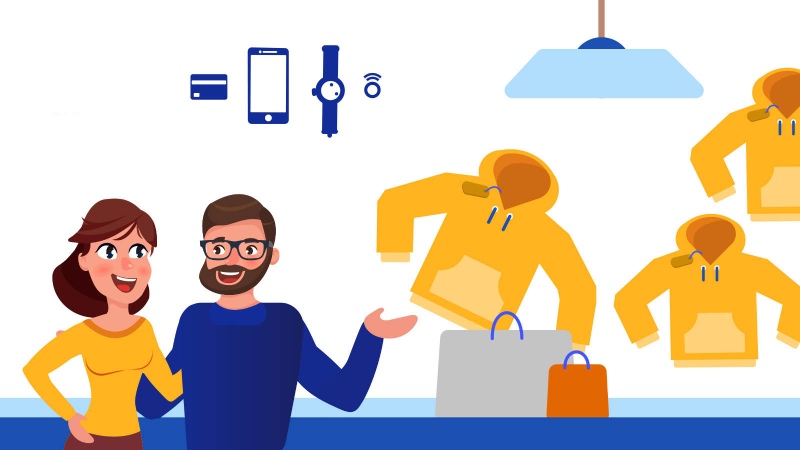Pay with Visa: convenient, safe, reliable
Most of us have long been accustomed to fast and safe payment in stores. The ability to use a card without additional fees, not to stand in line for a long time, not to think about a forgotten wallet with cash, to receive cashback for purchases.
Safety became especially important in 2020, when we were all forced to limit physical contact, especially when shopping. When using cash can pose a health risk, it's good to have a contactless alternative, namely cashless payments.
Visa takes pride in providing secure and innovative payment solutions for billions of users worldwide. Payments with Visa mean saving time, security, and protection against fraud during transactions, as well as the ability to request refunds if something goes wrong.
Moreover, with Visa, the advantage is not only for the customer but also for the merchant. Cashless payments help stores improve the quality and speed of service, which often leads to increased sales.
Of course, any form of payment (cash, card, or otherwise) involves certain expenses. Lately, there has been an increasing discussion about the cost and value of cashless payments for businesses and their customers. Let's explore together how payments for purchases with the Visa payment system take place, who participates in it, and who ultimately pays for it. Let's figure out together how to pay for a purchase using the Visa payment system, who participates in it, and who ultimately pays for it.
What happens when paying with VISA?
Yuri and Nastya choose a gift for their friend.
- Come on! Shall we buy online or in a shopping center?
- Let's go to the shopping center and try it on!

Payment methods

Cashless payments with
- Card
- Smartphone
- Smartwatch
How does the payment process work?
Issuing bank
- Provides access to contactless payments
- Verifies the authenticity of a transaction
- Protects Yuri and Nastya against cyber fraudsters
- Helps control their expenses
VISA (Global Payment Technology Company)
- Identifies Yuri and Nastya's card
- Guarantees the security of payments with multi-level protection and protects against cyber fraudsters
- Responsible for information exchange between the issuing bank and the acquiring bank
- Provides 24/7 customer support
Acquiring bank:
- Allows the store to accept cashless payments
- Guarantees receipt of payment
- Keeps a record of each transaction

Q: Do I need to pay anything extra for bank and Visa services?
A: Of course not! The price of the hoodie covers all possible commissions, including interbank commissions.
Q: And why is it needed?
A: Interbank commission (intercharge) is a commission that the acquiring bank pays to the issuing bank for each transaction with Visa

Bonuses for clients
- Free card service
- Cashback on purchases
- Preferential service for credit cards
- Discounts and loyalty programs
Frequently asked questions
-
Interbank commission (interchange) is a commission that the acquiring bank serving the seller or trade and service company pays to the issuing bank that issued the buyer's card for each transaction for payment of goods or services carried out using the card. In fact, the commission is redistributed between two banks, which is why it is called interbank.
-
It ensures the functioning of the cashless payments market. Banks invest their income from the interbank commission to install and maintain terminals for electronic payments in stores; maintain and improve fraud protection systems; fund the development of new payment technologies, such as paying by phone, and much more. Thanks to such investments, both buyers and businesses get faster access to a wider range of payment solutions and capabilities.
In addition, banks often use interbank commission income to create benefits for cardholders. Thanks to the interbank commission, today we have free cards, a cashback system, grace periods for loans and many other bonus programs.
-
The rate of the interbank commission is determined by the payment system based on objective market factors. It is not a source of income for payment systems.
-
Visa sets the size of the interbank commission, based on the level of market development, as well as the need to stimulate its development — to introduce new payment solutions, to expand the infrastructure of cashless payments.
In particular, the commission rate may depend on:
- type of store;
- cost of goods;
- type of payment;
- payment processing technology used by the seller;
- the country/region where the payment was made.
That is, cashless payments at gas stations, payments to the state, in fast food restaurants or at a car rental service have their own specifics, and the commission rate for them may differ.
-
Definitely yes.
The interbank commission is one of the main sources of investment in expanding the infrastructure of cashless payments. The volume of investments directly affects the speed of development of the "cashless economy". And in the era of the pandemic, this is an opportunity:
- for buyers – to pay contactless or order goods and services online, without risk to health;
- for small and medium-sized businesses – to quickly transfer work online and keep clients;
- for the economy – to recover faster thanks to the transition of business from a shadow cash economy to a transparent cashless one.
-
Interbank commission does not directly affect prices. The cost of goods and services for the consumer is the same whether paying in cash or by card.
-
No. The experience of other countries, such as the EU and Australia, shows that the reduction of the commission does not lead to a clear decrease in the prices of goods and services.
-
Visa consistently supports market-based tools for managing interbank commission rates around the world. We are actively working with regulators — Central Banks to determine the level of such a commission, which will contribute to the effective development of cashless infrastructure. This approach makes it possible to ensure equal conditions for all parties, while supporting the active development of the country's economy.

